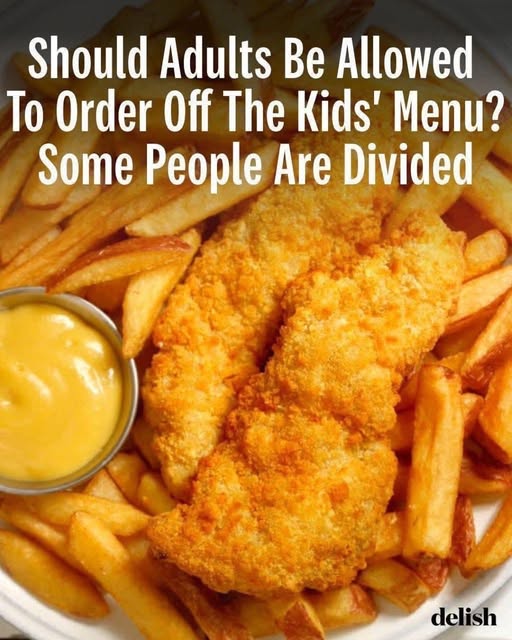Should Adults Be Allowed to Order Off the Kids’ Menu? Exploring Both Sides of the Plate
The sight of chicken tenders, mac and cheese, or mini burgers can ignite warm nostalgia for many adults. These staples of childhood cuisine, often found on the kids’ menu, continue to appeal to grown-ups with their simplicity, affordability, and comforting familiarity. But a common question arises in restaurants across the country: Should adults be allowed to order from the kids’ menu?
This debate has sparked strong opinions from foodies, restaurant owners, and diners alike. While some believe adults should have full freedom in what they eat, others argue that the kids’ menu has a specific purpose and demographic.
Let’s take a comprehensive look at both sides of the issue—and explore whether a delicious middle ground can be reached.
Why Some Adults Want to Order Off the Kids’ Menu
1. Portion Control for Mindful Eating
One of the strongest arguments in favor of letting adults order kids’ meals is portion size. In an era where over-sized portions are a leading contributor to food waste and dietary concerns, many health-conscious adults prefer the smaller, more manageable servings found on the kids’ menu.
Whether someone is tracking calories, recovering from surgery, or simply not hungry enough for a full entrée, downsizing portions makes perfect sense.
2. Nostalgic, Simple Comfort Foods
Let’s face it—sometimes adults just want simple, no-fuss food. Dishes like grilled cheese, buttered noodles, or crispy chicken tenders evoke childhood memories and deliver pure, uncomplicated joy.
The kids’ menu often includes these timeless classics, offering adults an opportunity to revisit their favorite flavors in a way that a fancy entrée never could.
3. Budget-Friendly Dining
In a world of inflation and rising dining costs, the kids’ menu can offer a more affordable alternative. Adults who are on a tight budget, or simply not in the mood for a $25 entrée, may appreciate the chance to enjoy a smaller, less expensive option without sacrificing the experience of eating out.
It’s especially appealing for solo diners, students, or travelers who want a quick bite without breaking the bank.
4. Freedom to Choose Without Judgment
Food is a deeply personal experience, and many adults believe they should be able to choose whatever they want to eat without being judged by restaurant staff or fellow diners.
In the spirit of individual freedom and inclusivity, why should anyone feel embarrassed or restricted when all they want is a simple bowl of mac and cheese?
Why Some Say Adults Shouldn’t Order From the Kids’ Menu
1. Designed Specifically for Children’s Needs
Kids’ menus are typically created with children’s nutritional needs and palates in mind. These dishes often feature fewer spices, less seasoning, and smaller portions to cater to younger, developing tastes.
For adults, these meals may not offer the balanced nutrition or portion size necessary for a healthy diet, making them less appropriate as a long-term option.
2. Restaurant Economics and Profit Margins
Most kids’ meals are priced below cost or offered at slim margins with the assumption that adult meals will subsidize them. When adults consistently order from the kids’ menu, it can impact a restaurant’s bottom line, especially in smaller, family-owned businesses.
Many establishments have clear policies that restrict the kids’ menu to diners under a certain age, and enforcing these policies protects their pricing model and business sustainability.
3. Social Etiquette and Dining Norms
There remains a stigma in some dining environments when adults order off the kids’ menu. Whether it’s a raised eyebrow from a waiter or an awkward moment at a group dinner, social perception can play a big role.
Even in casual settings, the action can sometimes be interpreted as childish or inappropriate, depending on the company and context.
Finding Common Ground: Is There a Solution?
Given the valid points on both sides, many believe the best approach is offering more flexibility within the standard menu.
A “Small Plates” or “Lite Bites” Section
Restaurants could introduce a smaller portions section of their main menu, featuring simpler, nostalgic meals at a reduced price. This would allow adults to enjoy kid-friendly favorites in an adult-friendly format, helping businesses maintain their margins while satisfying diner preferences.
Combo or Duo Options
Another potential solution is the introduction of combo plates, allowing diners to select two smaller dishes—like a soup and grilled cheese—offering variety and balance without overindulgence.
Clear Policy with Compassionate Enforcement
For restaurants that choose to enforce age restrictions on the kids’ menu, doing so with kindness and transparency is key. Posting clear signage or including notes on menus avoids uncomfortable confrontations and helps set expectations early.
Real-World Examples and Evolving Dining Trends
Many popular chains and cafes have already adapted to the growing demand for smaller, more affordable meals. Establishments like Panera, Cheesecake Factory, and even some high-end bistros have begun to feature light entrées, half-size portions, and simplified classics on their menus.
This trend reflects a broader cultural shift toward personalized dining, where customers expect flexibility, dietary accommodation, and emotional connection to food.
As consumers grow more mindful of what they eat and how much they spend, restaurants that respond to this demand often see greater customer loyalty and satisfaction.
Conclusion: Food Should Be About Choice and Joy
At the heart of the kids’ menu debate lies a deeper truth: food is personal. It’s about nourishment, memory, culture, and comfort. Restricting someone’s meal choice—especially when driven by portion, budget, or preference—can take away from the simple joy of dining out.
While restaurants have every right to enforce policies that protect their business, the most successful establishments find ways to balance profitability with customer experience.
So whether you’re in the mood for filet mignon or fish sticks, your plate should reflect your cravings—not your birth year.
